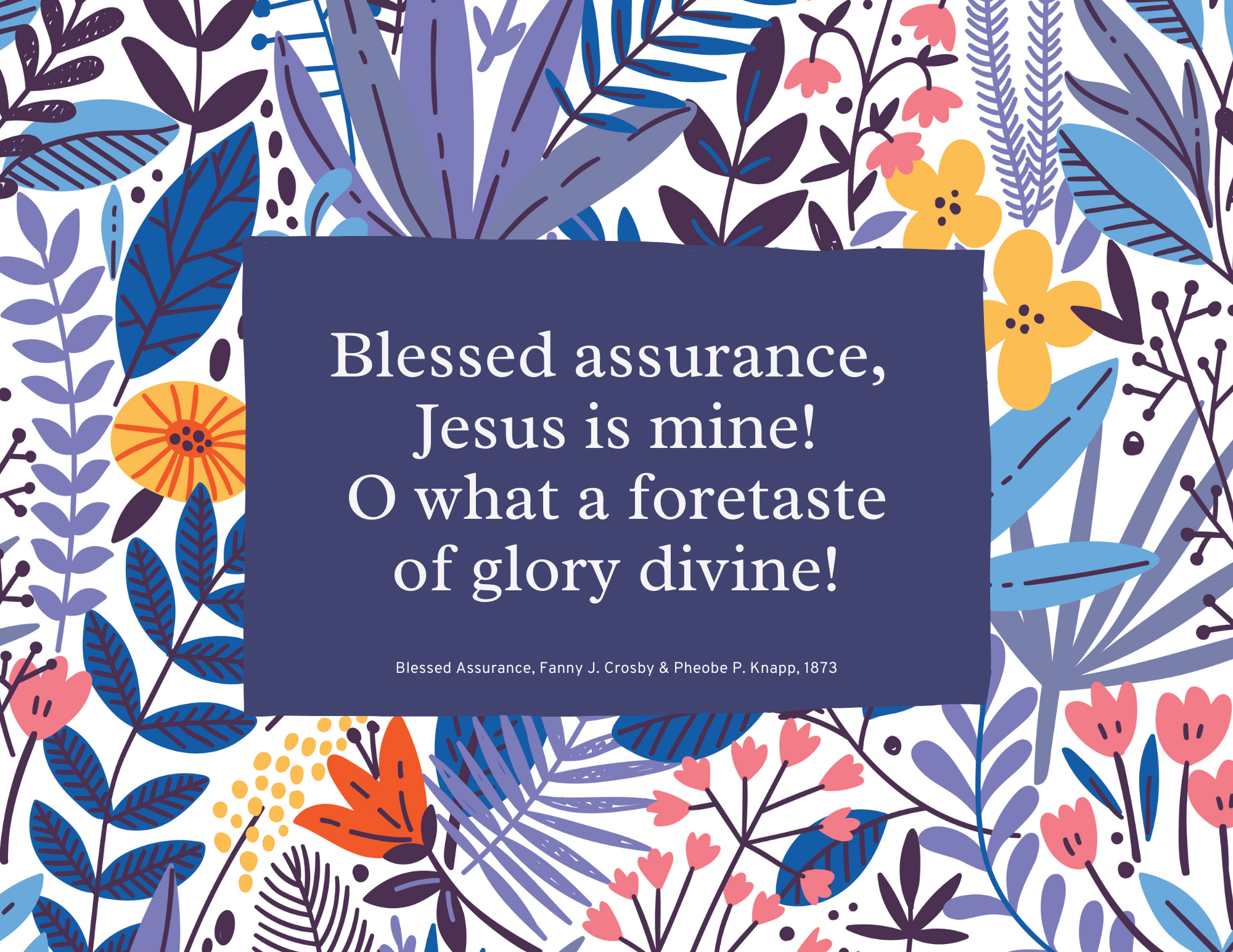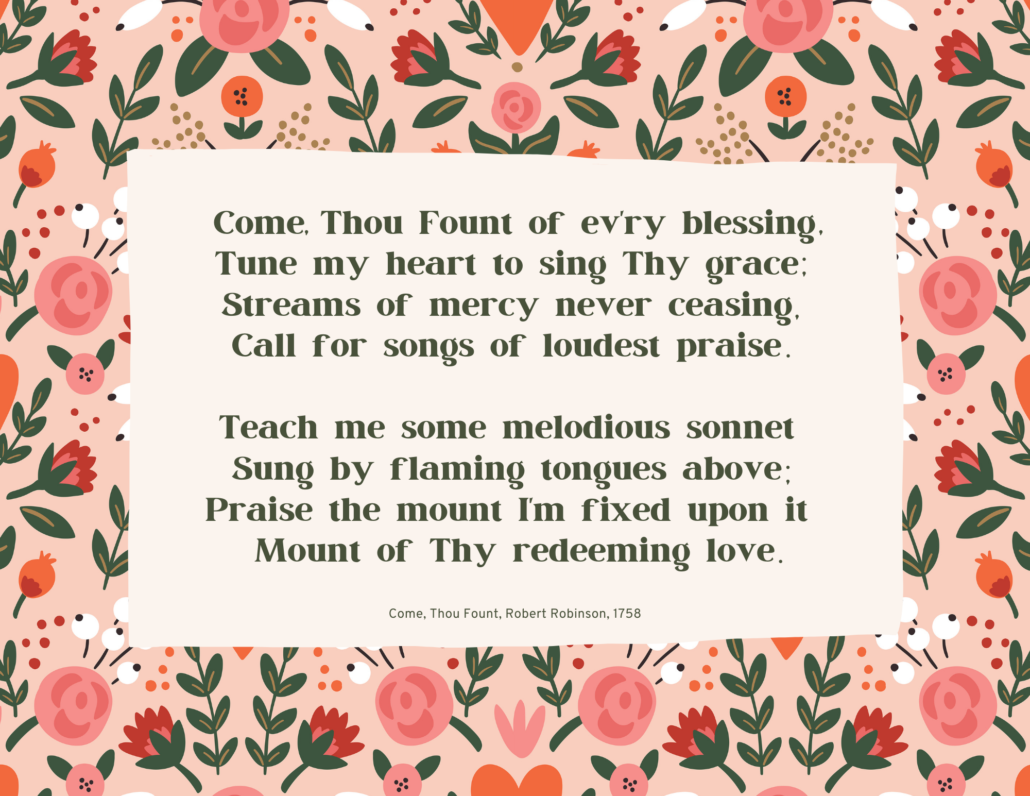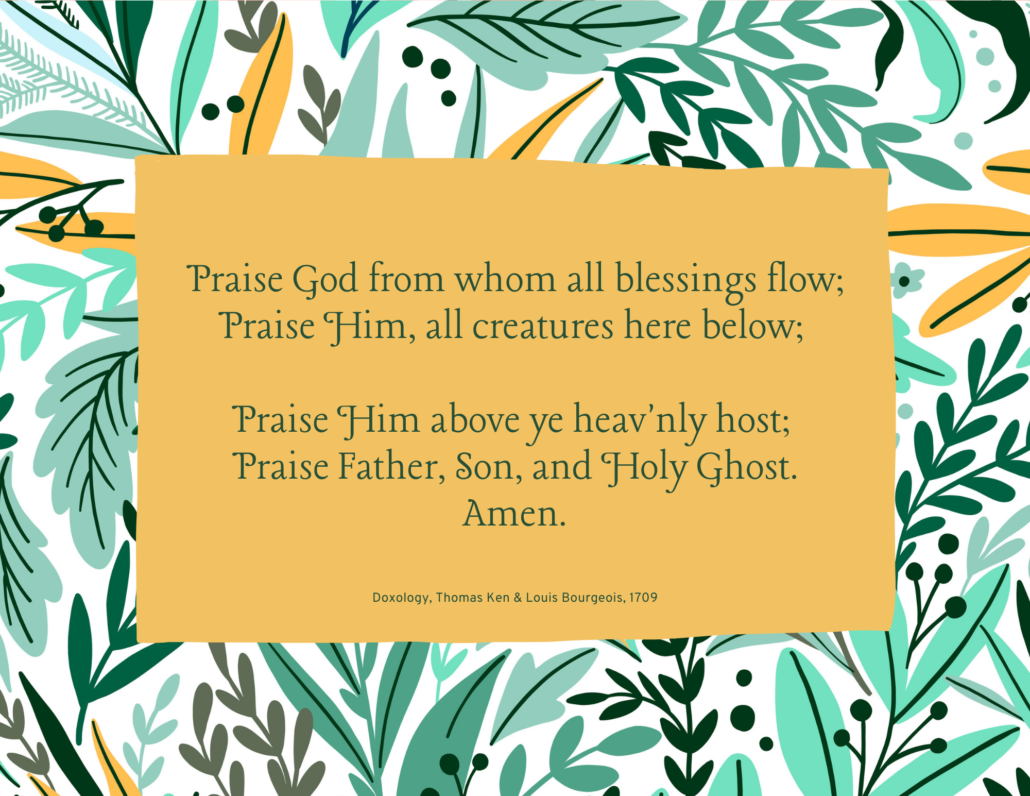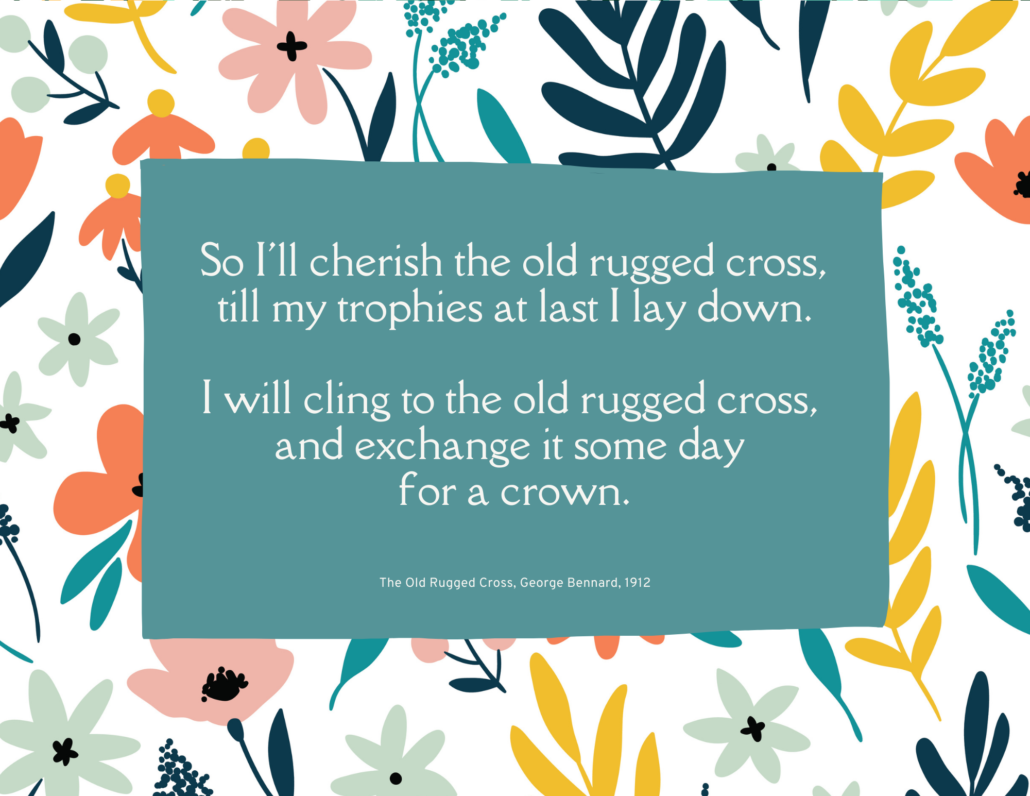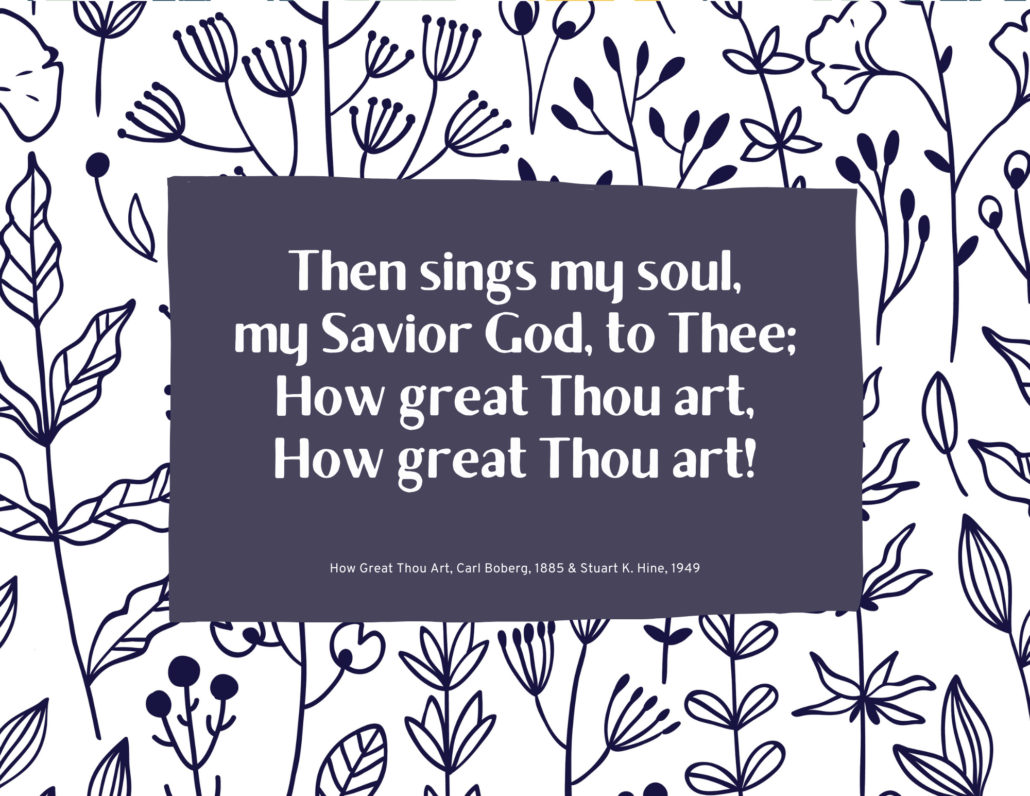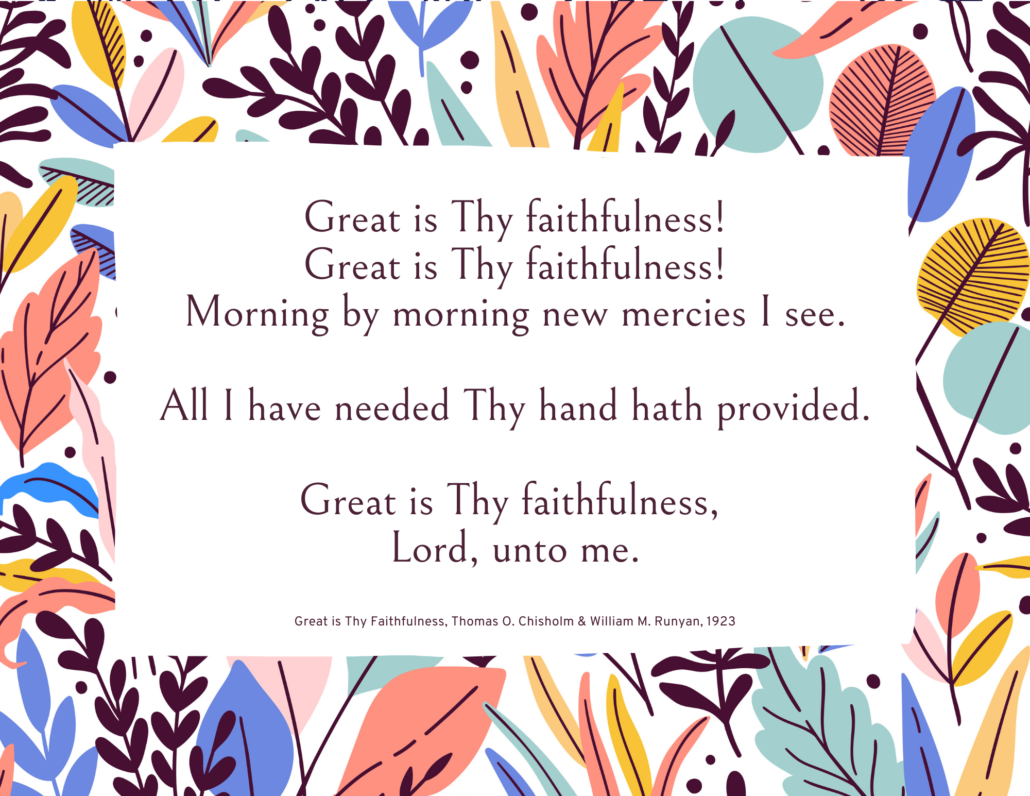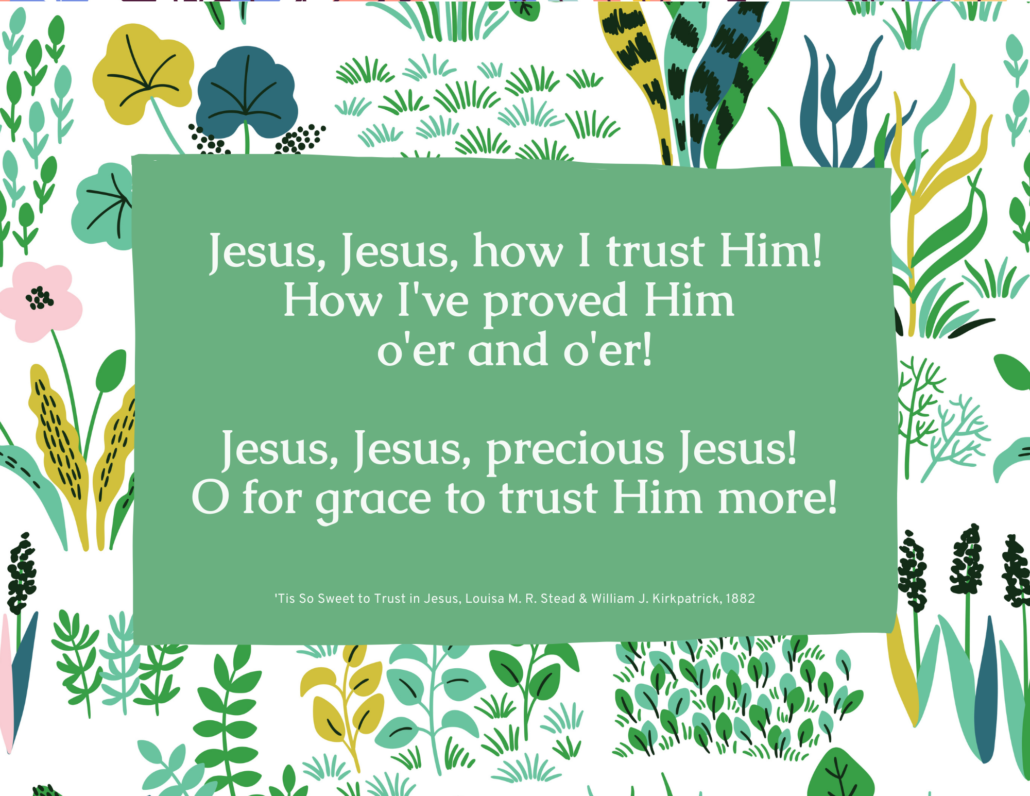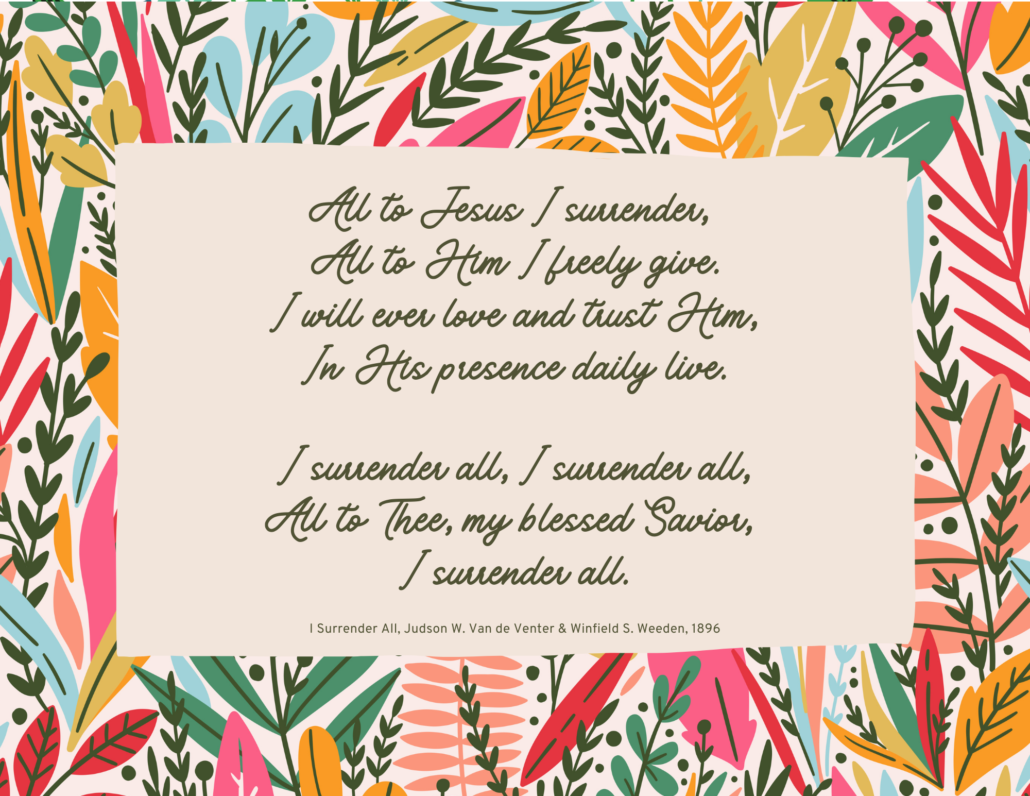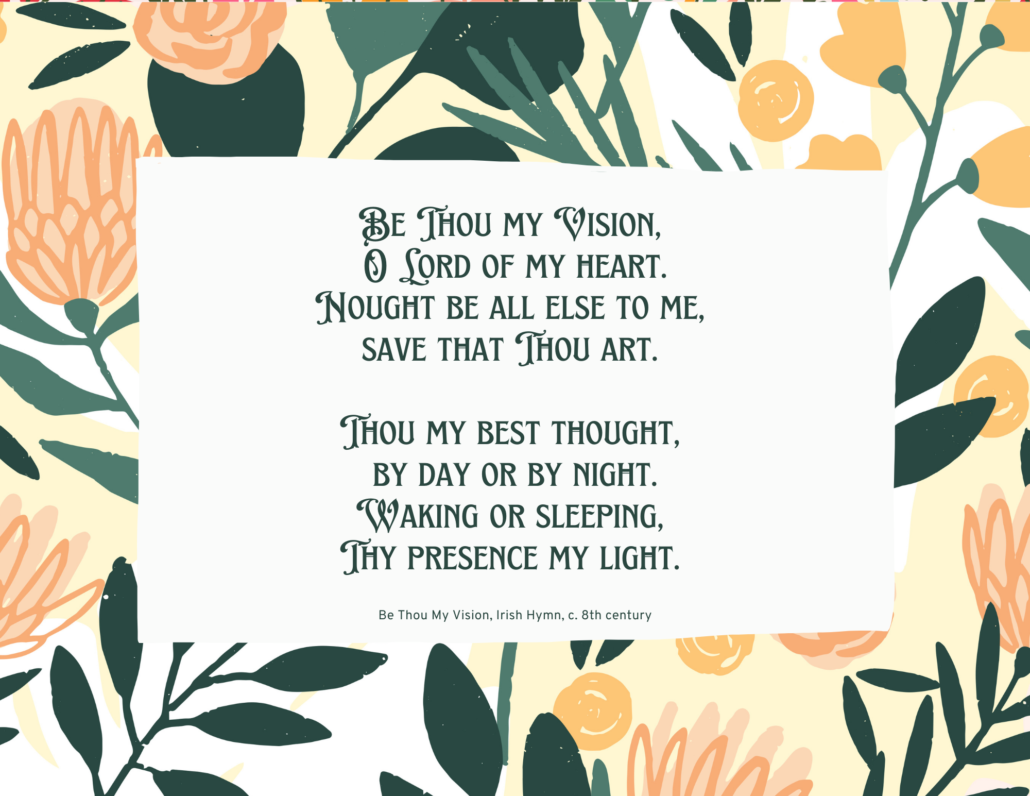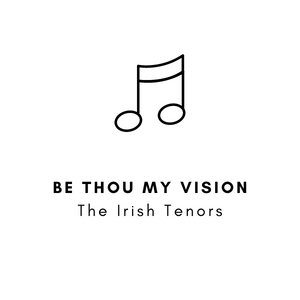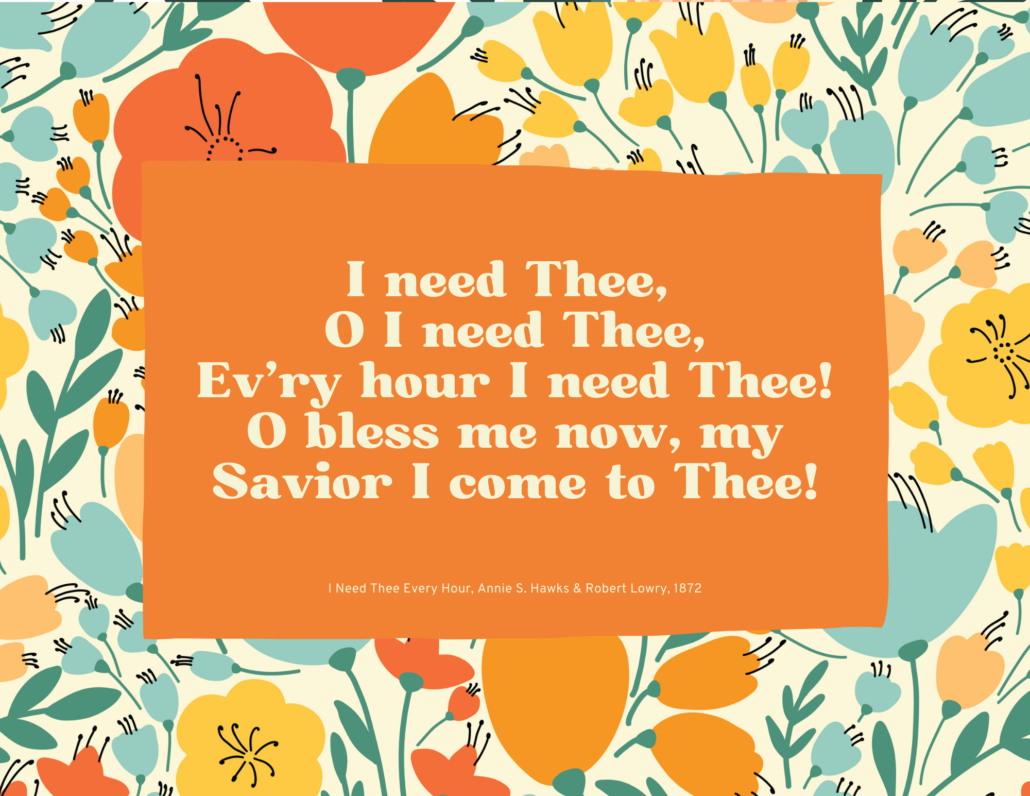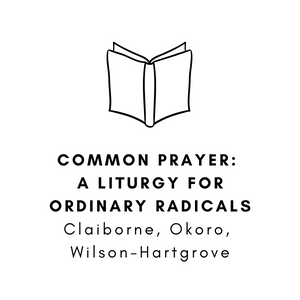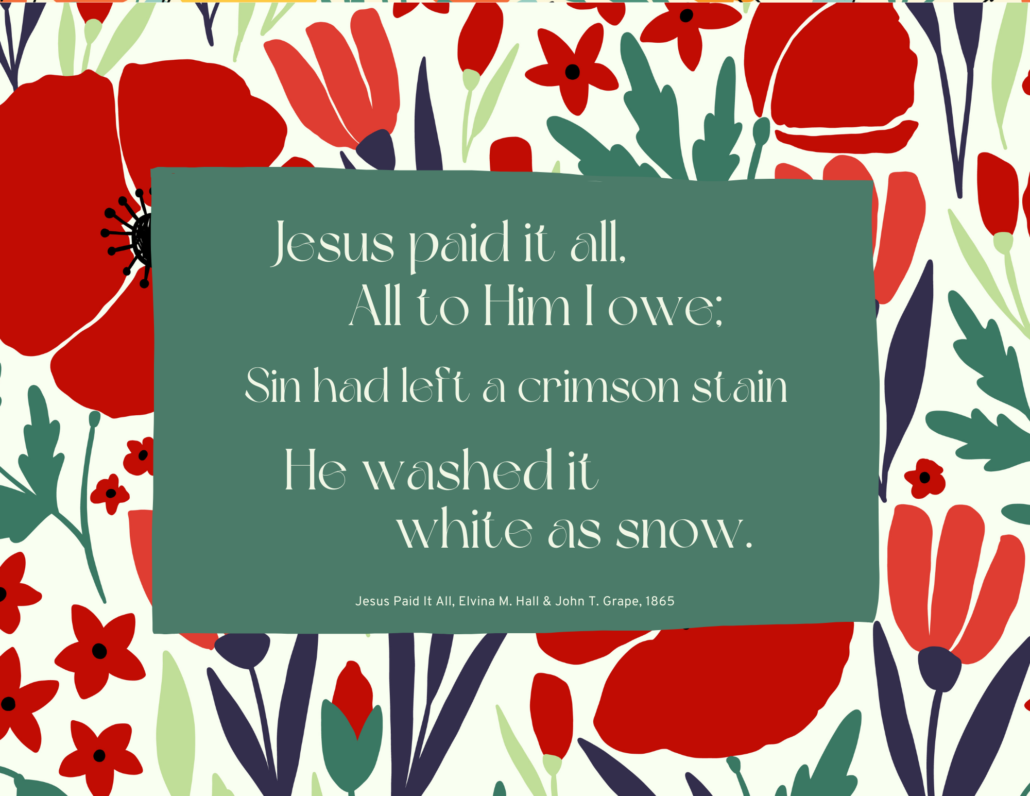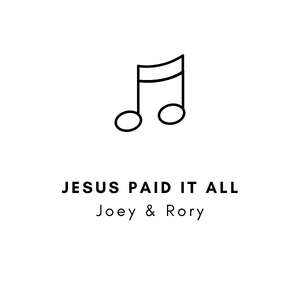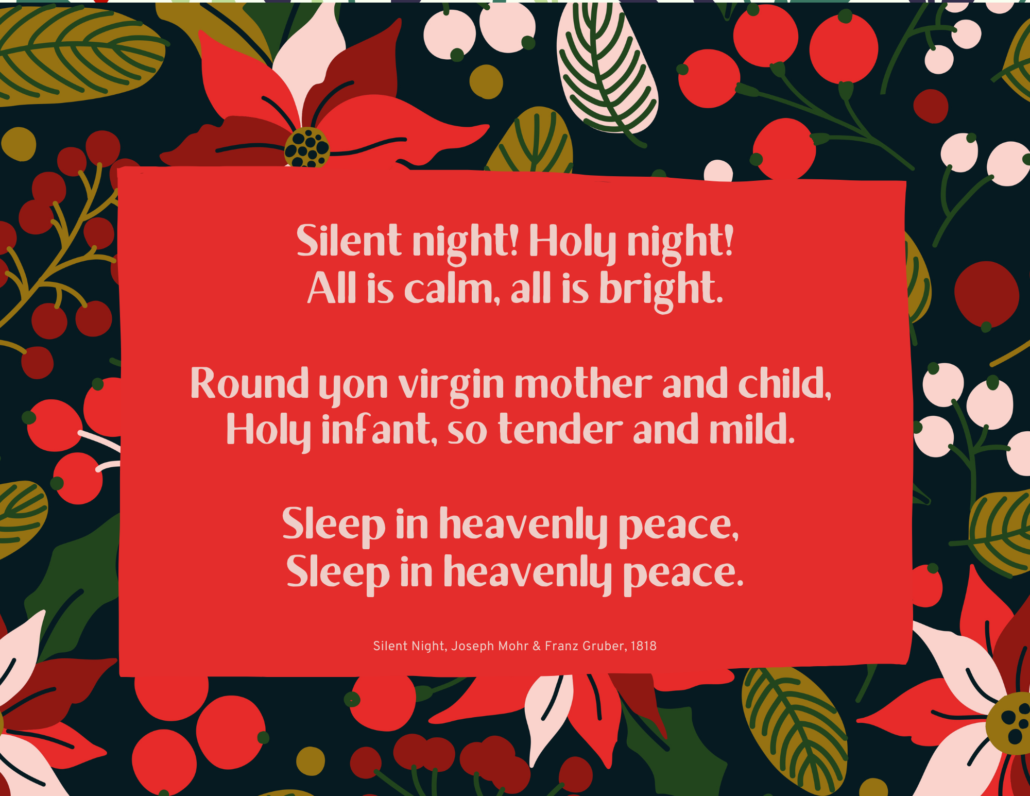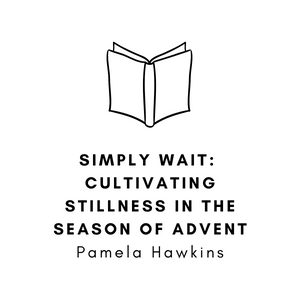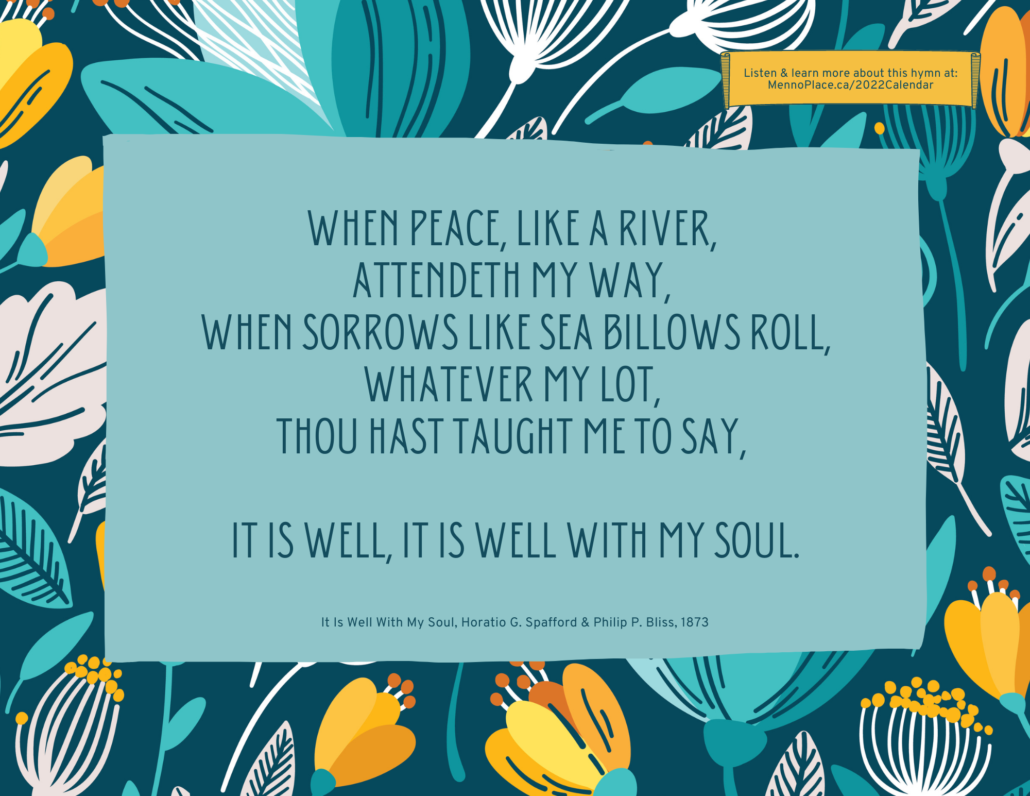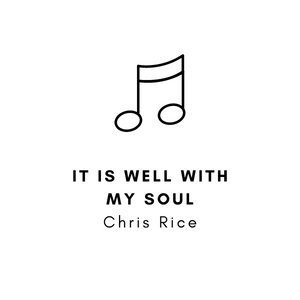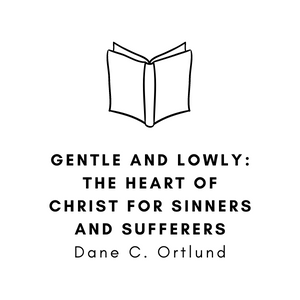Would you like to receive the Menno Place 2022 Calendar filled with hymn stories?
Featuring original artwork and some of the most beloved hymns, we would love to gift this beautiful calendar to you. Visit this page each month to read the stories behind these very special hymns!
Pick up your calendar at Menno Place OR click the button below if you would like a calendar mailed to you.
January
Blessed Assurance
Author: Fanny J. Crosby
Composer: Phoebe P. Knapp
Frances Jane Crosby, perhaps more than any other writer, truly captured the spirit of the American gospel song movement. It is estimated that Fanny Crosby wrote more than 8,000 gospel song texts in her lifetime. Her hymns have been and are still being sung more frequently than those of any other gospel hymn writer.
It is truly amazing that anyone could write on this variety of spiritual truths and experiences with such proliferation. For a considerable period during her life, while under contract to a music publisher, she wrote three new hymns each week. She used over 200 pen names besides her own. Many of her original texts are still being uncovered. Often the themes for her hymns were suggested by visiting ministers wishing to have a new song on a particular subject. At other times musician friends would first compose the music and then ask Fanny Crosby for the words.
Such was the case for the hymn, “Blessed Assurance.” The music for the hymn was composed by Phoebe Knapp, an amateur musician and close personal friend of Fanny Crosby. One day Mrs. Knapp played this melody for the blind poetess and asked, “What does this tune say?” Fanny responded immediately, “Why, that says: ‘Blessed Assurance, Jesus Is Mine.’ ”
Fanny Crosby died at the age of 95. Only eternity will disclose the host of individuals who have been won to a saving faith in Jesus Christ or those whose lives have been spiritually enriched through the texts of her many hymns.
Excerpted from 101 Hymn Stories: The Inspiring True Stories Behind 101 Favorite Hymns by Kenneth W. Osbeck. pgs. 42-44.
February
Come, Thou Fount
Author: Robert Robinson
Composer: John Wyeth
Robert Robinson was born of lowly parents in Swaffham, Norfolk, England, on September 27, 1735. His father died when Robert was eight, and at the age of fourteen he was sent by his mother to London to learn the barbering trade. Here for the next few years he was associated with a notorious gang of hoodlums and lived a debauched life. At the age of seventeen he attended a meeting where George Whitefield was preaching. Robinson and his friends went for the purpose of “scoffing at the poor, deluded Methodists.” However, Whitefield’s strong evangelistic preaching so impressed young Robinson that he was converted to Christ. Several years later he felt called to preach and entered the ministry of the Methodist Church. Subsequently, he left the Methodist Church when he moved to Cambridge and became a Baptist pastor. Here he became known as an able theologian through his writing of many theological works as well as several hymns.
This hymn text, written when Robinson was only twenty-three years of age, contains an interesting expression in the second stanza, “Here I raise mine Ebenezer – Hither by Thy help I’m come.” This language is taken from 1 Samuel 7:12, where Ebenezer is a symbol of God’s faithfulness. An expression in the third verse, “Prone to wander – Lord I feel it – Prone to leave the God I love,” seems to have been prophetic of Robinson’s later years, as once again his life became characterized by lapses into sin, unstableness, and an involvement with the doctrines of Unitarianism.
The story is told that Robinson was one day riding a stagecoach when he noticed a woman deeply engrossed with a hymn book. During an ensuing conversation the lady turned to Robinson and asked what he thought of the hymn she was humming. Robinson burst into tears and said, “Madam, I am the poor unhappy man who wrote that hymn many years ago, and I would give a thousands worlds, if I had them, to enjoy the feelings I had then.”
Excerpted from 101 Hymn Stories: The Inspiring True Stories Behind 101 Favorite Hymns by Kenneth W. Osbeck. pgs. 51-53.
March
Doxology
Author: Thomas Ken
Composer: Louis Bourgeois
The four lines of the Doxology have been the most frequently sung words of any known song for more than three hundred years. Even today nearly every English-speaking Protestant congregation still unites at least once each Sunday in this noble ascription of praise. It has been said that the doxology has done more to teach the doctrine of the Trinity than all the theological books ever written.
The author of this text was a bold, outspoken seventeenth century Anglican Bishop named Thomas Ken. His illustrious career in the ministry was stormy and colorful. King Charles II appointed Ken as one of his own chaplains. Ken revealed a spirit of boldness in rebuking the moral sins of his dissolute English monarch. Despite these rebukes Charles always admired the courageous chaplain. When it was chapel time, he would usually say, “I must go in and hear Ken tell me my faults.” Soon after the death of Charles II, Ken incurred the wrath of the new monarch, papist James II, and with six other Anglican Church leaders he was imprisoned in the Tower of London. Ken was eventually acquitted and spent the remaining years of his life in quiet obscurity.
Bishop Ken wrote a number of hymns, and it was always his desire that Christians be allowed to express their praise to God without being limited only to Psalmody and the Bible canticles. He was one of the first English writers to produce hymns that were not merely versifications of the Psalms. In 1673 Thomas Ken wrote a book entitled A Manual of Prayers for the Use of the Scholars of Winchester College. In one of the editions of this manual, Ken included three of his hymns that he wanted the students to sing each day as part of their devotions. These hymns were called “Morning Hymn,” “Evening Hymn,” and “Midnight Hymn.” Each of these hymns closed with the familiar four lines we now know as the Doxology.
The tune for Bishop Ken’s text, “Old Hundredth,” is said to be the most famous of all Christian hymn tunes. It was composed by Louis Bourgeois in 1551.
Excerpted from 101 Hymn Stories: The Inspiring True Stories Behind 101 Favorite Hymns by Kenneth W. Osbeck. pgs. 51-53.
April
The Old Rugged Cross
Author & Composer: George Bennard
This gospel hymn, a sentimental favorite of Christians and unsaved alike, was written by George Bennard in 1913. It is generally conceded to be the most popular of all twentieth century hymns.
Bennard was ordained by the Methodist Episcopal Church, where his devoted ministry was highly esteemed. For some time he was busily involved in conducting revival services, especially throughout the states of Michigan and New York. One time, after returning to Michigan, he passed through a trying experience which caused him to reflect seriously about the significance of the cross and what the Apostle Paul meant when he spoke of entering into the fellowship of Christ’s suffering. As Bennard contemplated these truths, he became convinced that the cross was more than just a religious symbol but rather the very heart of the gospel. “The Old Rugged Cross” became one of the most widely published songs, either sacred or secular, in the United States.
Bennard continued his evangelistic ministries for forty additional years following the writing of this hymn. He wrote other favorite gospel hymns, but none ever achieved the response of this hymn. Although it has often been stated that we do not worship the cross as such but rather the Christ of the cross, one cannot ponder the truths of Christ’s atonement without a keen awareness of the centrality of the cross in God’s plan of redemption for lost mankind.
Excerpted from 101 Hymn Stories: The Inspiring True Stories Behind 101 Favorite Hymns by Kenneth W. Osbeck. pgs. 254-256.
May
How Great Thou Art
Author: Carl Boberg
English Words & Music Arrangement: Stuart K. Hine and Manna Music of Swedish Folk Melody
The popularity of this hymn is due in large part to its wide use by favorite gospel singers in the twentieth century. However it was not until Cliff Barrows and George Beverly Shea of the Billy Evangelistic Team used it during the famed London Crusade in Harringay Arena that “How Great Thou Art” started to become universally well-know.
The original Swedish text was a poem entitled “O Store Gud,” written by a Swedish pastor, the Reverend Carl Boberg, in 1886. His inspiration for this text is said to have come from a visit to a beautiful country estate on the southeast coast of Sweden. He was suddenly caught in a midday thunderstorm with awe-inspiring moments of flashing violence, followed by a clear brilliant sun. Soon afterwards he heard the calm, sweet songs of the birds in nearby trees. The experience prompted the pastor to fall to his knees in humble adoration of his mighty God. He penned his exaltation in a nine-stanza poem.
Several years later Boberg was attending a meeting and was surprised to hear the congregation sing his poem to the tune of an old Swedish melody. The hymn was subsequently translated into German, Russian, and a literal English translation. In 1933 the Reverend Stuart Hine and his wife, English missionaries, were ministering to the people of the Ukraine. It was there they learned the Russian translation from a congregation of Ukrainians. The thought of writing original English lyrics to this song did not then occur to them – that was to await their crossing into Sub-Carpathian Russia, where the mountain scenery was to play its part. The thoughts of the first three verses in English were born, line upon line, amid unforgettable experiences in the Carpathian mountains. The fourth verse was written later in England after the war.
With his original English lyrics and his arrangement of the Swedish folk melody, Hine published what we know today as the hymn “How Great Thou Art.”
Excerpted from 101 Hymn Stories: The Inspiring True Stories Behind 101 Favorite Hymns by Kenneth W. Osbeck. pgs. 98-100.
June
Great Is Thy Faithfulness
Author: Thomas O. Chisholm
Composer: William M. Runyan
While many hymns are born out of a particular dramatic experience, this hymn was simply the result of the author’s morning by morning realization of God’s personal faithfulness. Thomas Chisholm was born in a humble log cabin in Franklin, Kentucky in 1866. He wrote more than 1200 poems, many of which have appeared frequently in such religious periodicals as the Sunday School Times, Moody Monthly, Alliance Weekly and others. A number of these poems have become prominent hymn texts.
In 1923 Mr. Chisholm sent several of his poems to the Rev. W. M. Runyan, a musician associated with the Moody Bible Institute and an editor with the Hope Publishing Company. This hymn was the favorite of Dr. Will Houghton, former beloved president of the Moody Bible Institute. It has since been an all-time favorite with students at the school and as a result its usefulness has spread to evangelical churches everywhere.
Excerpted from 101 Hymn Stories: The Inspiring True Stories Behind 101 Favorite Hymns by Kenneth W. Osbeck. pgs. 83-85.
July
’Tis So Sweet to Trust in Jesus
Author: Louisa M. R. Stead
Composer: William J. Kirkpatrick
“‘Tis So Sweet to Trust in Jesus” was written by a most remarkable woman, Louisa M. R. Stead, out of one of her darkest hours – the tragic drowning of her husband.
Louisa Stead was born about 1850, at Dover, England. As a youngster she felt the call of God upon her life for missionary service. She arrived in America in 1871. In 1875, Louisa married a Mr. Stead, and to this union was born a daughter, Lily. When the child was four years of age, the family decided one day to enjoy the sunny beach at Long Island Sound, New York. While eating their picnic lunch, they suddenly heard cries of help and spotted a drowning boy in the sea. Mr. Stead charged into the water. As often happens, however, the struggling boy pulled his rescuer under the water with him, and both drowned before the terrified eyes of wife and daughter. Out of her “why?” struggle with God during the ensuing days flowed these meaningful words from the soul of Louisa Stead: “‘Tis so sweet to trust in Jesus, just to take Him at His word; Just to rest upon His promise; just to know, ‘Thus saith the Lord.'”
The composer of the music, William James Kirkpatrick, was one of the influential nineteenth-century composers and publishers who did much to promote the cause of early gospel music. Kirkpatrick composed this tune especially for Mrs. Stead’s text with the hymn first appearing, in 1882, in the collection Songs of Triumph.
Excerpted from 101 More Hymn Stories: The Inspiring True Stories Behind 101 Favorite Hymns by Kenneth W. Osbeck. pgs. 287-289.
August
I Surrender All
Author: Judson W. Van de Venter
Composer: Winfield S. Weeden
Following graduation from Hillsdale College, Judson Van de Venter became an art teacher and later a supervisor of art in the public schools of Sharon, Pennsylvania. He was also an active layman in his Methodist Episcopal Church. Recognizing his unusual talent for Christian service, his friends began urging him to give up teaching and become an evangelist. For the next five years, Mr. Van de Venter wavered between the challenge of the ministry and that of becoming a recognized artist.
This hymn text was written by the author as he recalled the day that he had surrendered his life to Christ and dedicated himself completely to Christian service. Mr. Van de Venter has left this account of the writing of his hymn text:
For some time, I had struggled between developing my talents in the field of art and going into full-time evangelistic work. At last the pivotal hour of my life came, and I surrendered all. A new day was ushered into my life. I became an evangelist and discovered down deep in my soul a talent hitherto unknown to me. God had hidden a song in my heart, and touching a tender chord, He caused me to sing.
Mr. Van de Venter was one of the evangelists who influenced Dr. Billy Graham’s preaching.
Excerpted from 101 More Hymn Stories: The Inspiring True Stories Behind 101 Favorite Hymns by Kenneth W. Osbeck. pgs. 135-136.
September
Be Thou My Vision
Text: Irish Hymn, c. 8th century
Translated by: Mary E. Byrne
Versified by: Eleanor H. Hull
Arrangement: Norman Johnson
This eighth-century, anonymous, Irish hymn text expresses, in the quaint Celtic style, the ageless need of man to have a heavenly vision and to experience God’s care and personal presence throughout this earthly pilgrimage. The author’s high regard for God is evident in the various titles ascribed Him: Vision, Lord, Best Thought, Wisdom, Word, Great Father, High King, Inheritance, Treasure, Sun, Ruler, and Heart.
Mary Byrne’s translation of this ancient Irish poem into English prose first appeared in the journal Erin, Volume Two, published in 1905. Later the prose was put into verse form by Eleanor H. Hull and published in her Poem Book of the Gael, 1912. The tune, “Slane,” is a traditional Irish air from Patrick W. Joyce’s collection, Old Irish Folk Music and Songs, published in 1909.
Excerpted from 101 More Hymn Stories: The Inspiring True Stories Behind 101 Favorite Hymns by Kenneth W. Osbeck. pgs. 42-44.
October
I Need Thee Every Hour
Authors: Annie S. Hawks & Robert Lowry
Composer: Robert Lowry
This deeply, personal hymn was written out of the daily experiences of a busy housewife and mother, Annie Hawks, in the year 1872. At a very early age, she displayed a gift for writing verse and by the age of fourteen was contributing poetry regularly to various newspapers. In all, she wrote more than 400 poems. For much of her life she lived in Brooklyn, New York, and was a member of the Hanson Place Baptist Church, where for eight years Dr. Robert Lowry, himself a prominent, gospel poet and musician, was her pastor. Mr. Lowry recognized Mrs. Hawks’ poetic gifts and encouraged her to use these abilities for writing hymn texts. Annie Hawks left the following account regarding the writing of her one immortal hymn:
One day as a young wife and mother of 37 years of age, I was busy with my regular household tasks during a bright June morning, in 1872. Suddenly, I became filled with the sense of nearness to the Master, and I began to wonder how anyone could ever live without Him, either in joy or pain. Then, the words were ushered into my mind and these thoughts took full possession of me – “I need Thee every hour…”
Later, Mrs. Hawks showed these four stanzas to Dr. Lowry, who was very much impressed with them. Lowry quickly composed the music for the verses and also added the refrain.
Mrs. Hawks has left this account regarding the spiritual help she received from her own hymn during this very difficult period of her life:
I did not understand at first why this hymn had touched the great throbbing heart of humanity. It was not until long years after, when the shadow fell over my way, the shadow of great loss, that I understood something of the comforting power in the words, which I had been permitted to give out to others in my hour of sweet serenity and peace.
Excerpted from 101 More Hymn Stories: The Inspiring True Stories Behind 101 Favorite Hymns by Kenneth W. Osbeck. pgs. 132-134.
November
Jesus Paid It All
Authors: Elvina M. Hall
Composer: John T. Grape
This hymn, often used for our communion services, speaks pointedly about the truth of the certainty of our personal relationship with God. The text was written by a lay woman named Elvina Hall. She wrote these words one Sunday morning, in 1865, while seated in the choir loft of the Monument Street Methodist Church of Baltimore, Maryland, supposedly listening to the sermon by her pastor, the Rev. George Schrick. During the course of the message, she began scribbling the words of the poem on the flyleaf of her church hymnal.
Mrs. Hall shared her verses with her pastor following the service. Several days before, the church organist, John Grape, also gave the pastor a copy of a new tune he had recently composed. Mr. Grape was a successful coal merchant in Baltimore, who, as he once said, “dabbled in music for my own amusement.” For many years he was an active lay-worker in the Monument Street Church, working in the Sunday school as well as serving as the organist-choir director.
We marvel at the workings of God on our behalf. An obscure woman scribbles a poem on the flyleaf of her hymnal, an amateur church musician unknowingly creates a matching tune, an unknown pastor provides encouragement and another hymn is born, that has since found an important place in our church hymnals and in turn has ministered spiritual challenge and blessing to countless numbers of people for more than a century.
Excerpted from 101 More Hymn Stories: The Inspiring True Stories Behind 101 Favorite Hymns by Kenneth W. Osbeck. pgs. 160-162.
December
Silent Night
Author: Joseph Mohr
English Translation: John F. Young
Composer: Franz Gruber
Joseph Mohr was born in Salzburg, Austria, in 1792. In 1815, Mohr was ordained to the priesthood of the Roman Catholic Church. It was while serving as an assistant priest in 1818, at the newly erected Church of St. Nicholas in Obernorf in the region of Tyrol, high in the beautiful Alps, that Mohr wrote the text for this favorite of all Christmas carols.
Father Mohr and Franz Gruber, the village schoolmaster and church organist, had often talked about the fact that the perfect Christmas hymn had never been written. With this goal in mind, and after he had received word that his own church organ would not function, Father Mohr decided that he must write his own Christmas hymn, immediately, in order to have music for the special Christmas Eve Mass and to avoid disappointing his faithful congregation. Upon completing the text, he took his words to Franz Gruber, who exclaimed when he saw them, “Friend Mohr, you have it – the right son – God be praised!”
Soon Gruber completed his task of writing the right tune for the new text. His simple but beautiful music blended perfectly with the spirit of Father Mohr’s words. The hymn was completed in time for the Christmas Eve Mass, and Father Mohr and Franz Gruber sang their hymn to the accompaniment of Gruber’s guitar. The hymn made a deep impact upon the parishioners, even as it has on succeeding generations. The passing of time seems only to add to its appeal.
The carol is presently sung in all of the major languages of the world and is a universal favorite wherever songs of the Christmas message are sung.
Excerpted from 101 Hymn Stories: The Inspiring True Stories Behind 101 Favorite Hymns by Kenneth W. Osbeck. pgs. 221-222.
January 2023
It Is Well With My Soul
Author: Horatio G. Spafford
Composer: Philip P. Bliss
As a young man, Horatio G. Spafford had established a successful legal practice in Chicago. Along with his financial success, he always maintained a keen interest in Christian activities. He enjoyed a close and active relationship with D.L. Moody and other evangelical leaders of that era. He was described by George Stebbins, a noted gospel musician, as a “man of unusual intelligence and refinement, deeply spiritual, and a devoted student of the Scriptures.”
Some months prior to the Chicago Fire of 1871, Spafford had invested heavily in real estate on the shore of Lake Michigan, and his holdings were wiped out by this disaster. Desiring a rest for his wife and four daughters as well as wishing to assist Moody and Sankey in one of their campaigns in Great Britain, Spafford planned a European trip for his family in November of 1873. Due to unexpected last minute business developments, he had to remain in Chicago, but he sent his wife and four daughters on ahead as scheduled on the S.S. Ville du Havre. He expected to follow in a few days. On November 22 the ship was struck by the Lochearn, an English vessel, and sank in twelve minutes. Several days later the survivors were finally landed at Cardiff, Wales, and Mrs. Spafford cabled her husband, “Saved alone.”
Shortly afterward Spafford left by ship to join his bereaved wife. It is thought that on the sea near the area where his four daughters had drowned, Spafford penned this text whose words so significantly describe his own personal grief – “When sorrows like sea billows roll…” It is noteworthy, however, that Spafford’s hymn does not dwell on the theme of life’s sorrows and trials buy focuses attention in the third stanza on the redemptive work of Christ and in the fourth stanza anticipates His glorious Second Coming. Humanly speaking, it is amazing that one could experience such personal tragedies and sorrows as Horatio Spafford did and still be able to say with such convincing clarity, “It is well with my soul.”
Excerpted from 101 Hymn Stories: The Inspiring True Stories Behind 101 Favorite Hymns by Kenneth W. Osbeck. pgs. 126-128.



